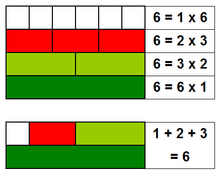完全数

完全数(Perfect number),又称完美数或完备数,是一些特殊的自然数:它所有的真因子(即除了自身以外的约数)的和,恰好等于它本身,完全数不可能是楔形数、平方数、佩尔数或费波那契数。
例如:第一个完全数是6,它有约数1、2、3、6,除去它本身6外,其余3个数相加,,恰好等于本身。第二个完全数是28,它有约数1、2、4、7、14、28,除去它本身28外,其余5个数相加,,也恰好等于本身。后面的数是496、8128。
完全数的发现
古希腊数学家欧几里得是通过 的表达式发现前四个完全数的。
- 当
- 当
- 当
- 当
一个偶数是完美数,当且仅当它具有如下形式:,其中是素数,此事实的充分性由欧几里得证明,而必要性则由欧拉所证明。
比如,上面的和对应着和的情况。我们只要找到了一个形如的素数(即梅森素数),也就知道了一个偶完美数。
尽管没有发现奇完全数,但是当代数学家奥斯丁·欧尔证明,若有奇完全数,则其形式必然是或的形式,其中是素数。
首十个完全数是(![]() A000396):
A000396):
历史
古代数学家根据当时已知的四个完全数做了很多假设,大部分都是错误的。其中的一个假设是:因为 2、3、5、7 恰好是头 4 个素数,第 5 个完全数应该是第 5 个素数,即当 的时候,可是 并不是素数。因此 不是完全数。另外两个错误假设是:
- 头四个完全数分别是 1、2、3、4 位数,第五个应该是 5 位数。
- 完全数应该是交替以 6 或 8 结尾。
事实上,第五个完全数 是 位数。
对于第二个假设,第五个完全数确实是以 结尾,但是1588年,意大利数学家彼得罗·卡塔尔迪计出第六个完全数 ,仍是以 结尾,只能说欧几里得的公式给出的完全数以 和 结尾。卡塔尔迪证明了此结论。此外,还计出第七个完全数137,438,691,328。[1][2][3]
对完全数的研究,至少已经有两千多年的历史。《几何原本》中就提出了寻求某种类型完全数的问题。
每一个梅森素数给出一个偶完全数;反之,每个偶完全数给出一个梅森素数,这结果称为欧几里得-欧拉定理。到 2018 年 12 月为止,共发现了 51 个完全数,且都是偶数。最大的已知完全数为 共有 位数。
性质
以下是目前已发现的完全数共有的性质。
- 偶完全数都是以6或28结尾[4][5]。
- 在十二进制中,除了6跟28以外的偶完全数都以54结尾,甚至除了6, 28, 496以外的偶完全数都以054或854结尾。[原创研究?][查证请求][来源请求]而如果存在奇完全数,它在十二进制中必定以1, 09, 39, 69或99结尾[6]。
- 在六进制中,除了6以外的偶完全数都以44结尾,甚至除了6, 28以外的偶完全数都以144或344结尾。[原创研究?][查证请求][来源请求]而如果存在奇完全数,它在六进制中必定以01, 13, 21或41结尾[6]。
- 除了6以外的偶完全数,把它的各位数字相加,直到变成个位数,那么这个个位数一定是1[4][5][注 1]:
→ → → → →
- 所有的偶完全数都可以表达为2的一些连续正整数次幂之和,从到:
- 每个偶完全数都可以写成连续自然数之和[注 2]:
- 每个完全数的所有约数(包括本身)的倒数之和,都等于2:(这可以用通分证得。因此每个完全数都是欧尔调和数。)
- 它们的二进制表达式也很有趣:(因为偶完全数形式均如)
奇完全数
用计算机已经证实:在101500以下,没有奇完全数;至今还证明了,如果奇完全数存在,则它至少包含11个不同素数(包含一个不少于7位数的素因子)但不包含3,亦不会是立方数。一般猜测:奇完全数是不存在的。完全数的个数是否为无限?至今都不能回答。
美国数学家卡尔·帕梅朗斯提出了一个想法说明奇完全数不太可能存在。[7]
奇完全数的部分条件
- N > 101500[8]
- N是以下形式:
- 其中:
- N必须可以写成12n+1,468n+117或324n+81(n为整数)的形式。[6]
- N不能被105整除。[12]
- N的最大素因子必须大于108[13],并低于 。[14]。
- N的第二大素因子必须大于104,并低于。[15][16] 。
- N的第三大素因子必须大于100。[17]
- N至少要有101个素因子,其中至少10个是不同的。[8][18] 如果3不是素因子之一,则至少要有12个不同的素因子。[19]
- 如果对于所有的i,都有 ≤ 2,那么:
- N的最小素因子必须大于739(Cohen 1987)。
- α ≡ 1(mod 12)或α ≡ 9 (mod 12)(McDaniel 1970)。
图查德定理
这个定理说明若存在奇完全数,其形式必如或。最初的证明在1953年由雅克·图查德首先证明,1951年巴尔塔萨·范德波尔用非线性偏微分方程得出证明。茱蒂·霍尔德纳在《美国数学月刊》第109卷第7期刊证了一个初等的证明。
证明会使用这四个结果:(下面的n,k,j,m,q均为正整数)
引理的证明(甲):
使用反证法,设为完全数,且。
。因为3的二次剩余只有0,1,故非平方数,因此其正约数个数为偶数。
有正约数,则可得:
- 且;或
- 且。
因此,。故。
但,矛盾。
故的形式只可能为或。
引理的证明(乙):
使用反证法,设为完全数,且。
。因为4的二次剩余只有0,1,故非平方数,因此其正约数个数为偶数。
有正约数,则可得:
- 且;或
- 且。
因此,。故。
但,矛盾。
故的形式只可能为。
若,根据欧拉的结果,,综合两者,得。
因为为积性函数,可得。
参考
- Odd Perfect Numbers(页面存档备份,存于互联网档案馆), Gagan Tara Nanda
注释
参考资料
- ^ Dickson, L. E. History of the Theory of Numbers, Vol. I. Washington: Carnegie Institution of Washington. 1919: 10.
- ^ Pickover, C. Wonders of Numbers: Adventures in Mathematics, Mind, and Meaning. Oxford: Oxford University Press. 2001: 360 [2021-11-08]. ISBN 0-19-515799-0. (原始内容存档于2022-03-22).
- ^ Peterson, I. Mathematical Treks: From Surreal Numbers to Magic Circles. Washington: Mathematical Association of America. 2002: 132 [2021-11-08]. ISBN 88-8358-537-2. (原始内容存档于2021-11-08).
- ^ 4.0 4.1 H. Novarese. Note sur les nombres parfaits Texeira J. VIII (1886), 11–16.
- ^ 5.0 5.1 Dickson, L. E. History of the Theory of Numbers, Vol. I. Washington: Carnegie Institution of Washington. 1919: 25.
- ^ 6.0 6.1 6.2 Roberts, T. On the Form of an Odd Perfect Number (PDF). Australian Mathematical Gazette. 2008, 35 (4): 244 [2021-03-15]. (原始内容存档 (PDF)于2013-05-14).
- ^ 存档副本. [2006-07-26]. (原始内容存档于2006-12-29).
- ^ 8.0 8.1 8.2 Ochem, Pascal; Rao, Michaël. Odd perfect numbers are greater than 101500 (PDF). Mathematics of Computation. 2012, 81 (279): 1869–1877 [2021-11-03]. ISSN 0025-5718. Zbl 1263.11005. doi:10.1090/S0025-5718-2012-02563-4
 . (原始内容 (PDF)存档于2016-01-15).
. (原始内容 (PDF)存档于2016-01-15).
- ^ Zelinsky, Joshua. On the Total Number of Prime Factors of an Odd Perfect Number (PDF). Integers. 3 August 2021, 21 [7 August 2021]. (原始内容 (PDF)存档于2021-11-03).
- ^ Chen, Yong-Gao; Tang, Cui-E. Improved upper bounds for odd multiperfect numbers.. Bulletin of the Australian Mathematical Society. 2014, 89 (3): 353–359.
- ^ Nielsen, Pace P. An upper bound for odd perfect numbers. Integers. 2003, 3: A14–A22 [23 March 2021]. (原始内容存档于2003-02-21).
- ^ Kühnel, Ullrich. Verschärfung der notwendigen Bedingungen für die Existenz von ungeraden vollkommenen Zahlen. Mathematische Zeitschrift. 1950, 52: 202–211. doi:10.1007/BF02230691 (德语).
- ^ Goto, T; Ohno, Y. Odd perfect numbers have a prime factor exceeding 108 (PDF). Mathematics of Computation. 2008, 77 (263): 1859–1868 [30 March 2011]. Bibcode:2008MaCom..77.1859G. doi:10.1090/S0025-5718-08-02050-9
 . (原始内容 (PDF)存档于2011-08-07).
. (原始内容 (PDF)存档于2011-08-07).
- ^ Konyagin, Sergei; Acquaah, Peter. On Prime Factors of Odd Perfect Numbers. International Journal of Number Theory. 2012, 8 (6): 1537–1540. doi:10.1142/S1793042112500935.
- ^ Zelinsky, Joshua. Upper bounds on the second largest prime factor of an odd perfect number. International Journal of Number Theory. July 2019, 15 (6): 1183–1189. arXiv:1810.11734
 . doi:10.1142/S1793042119500659..
. doi:10.1142/S1793042119500659..
- ^ Iannucci, DE. The second largest prime divisor of an odd perfect number exceeds ten thousand (PDF). Mathematics of Computation. 1999, 68 (228): 1749–1760 [30 March 2011]. Bibcode:1999MaCom..68.1749I. doi:10.1090/S0025-5718-99-01126-6
 . (原始内容 (PDF)存档于2021-11-03).
. (原始内容 (PDF)存档于2021-11-03).
- ^ Iannucci, DE. The third largest prime divisor of an odd perfect number exceeds one hundred (PDF). Mathematics of Computation. 2000, 69 (230): 867–879 [30 March 2011]. Bibcode:2000MaCom..69..867I. doi:10.1090/S0025-5718-99-01127-8. (原始内容存档 (PDF)于2013-05-17).
- ^ Nielsen, Pace P. Odd perfect numbers, Diophantine equations, and upper bounds (PDF). Mathematics of Computation. 2015, 84 (295): 2549–2567 [13 August 2015]. doi:10.1090/S0025-5718-2015-02941-X
 . (原始内容 (PDF)存档于2015-07-08).
. (原始内容 (PDF)存档于2015-07-08).
- ^ Nielsen, Pace P. Odd perfect numbers have at least nine distinct prime factors (PDF). Mathematics of Computation. 2007, 76 (260): 2109–2126 [30 March 2011]. Bibcode:2007MaCom..76.2109N. arXiv:math/0602485
 . doi:10.1090/S0025-5718-07-01990-4. (原始内容 (PDF)存档于2021-11-03).
. doi:10.1090/S0025-5718-07-01990-4. (原始内容 (PDF)存档于2021-11-03).
- ^ [1][永久失效链接]
参见
外部链接
- Hazewinkel, Michiel (编), Perfect number, 数学百科全书, Springer, 2001, ISBN 978-1-55608-010-4
- David Moews: Perfect, amicable and sociable numbers(页面存档备份,存于互联网档案馆)
- Perfect numbers – History and Theory(页面存档备份,存于互联网档案馆)
- 埃里克·韦斯坦因. Perfect Number. MathWorld.
- Sloane, N.J.A. (编). Sequence A000396 (Perfect numbers). The On-Line Encyclopedia of Integer Sequences. OEIS Foundation.
- OddPerfect.org A projected distributed computing project to search for odd perfect numbers.
- Great Internet Mersenne Prime Search[永久失效链接]
- Perfect Numbers(页面存档备份,存于互联网档案馆), math forum at Drexel.
- Grimes, James. 8128: Perfect Numbers. Numberphile. Brady Haran. [2015-01-10]. (原始内容存档于2013-05-31).
| ||||||||||||||||||||||||||||||||||
Text is available under the CC BY-SA 4.0 license; additional terms may apply.
Images, videos and audio are available under their respective licenses.













































































































